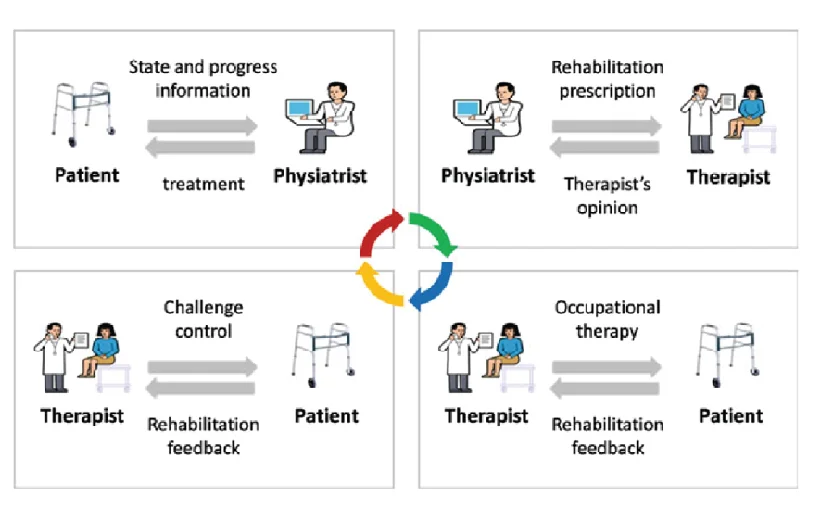When it comes to helping people recover from stroke and spinal cord injuries, occupational therapy (OT) is an essential part of the holistic rehabilitation process. These life-altering conditions can have a significant impact on a person's ability to perform basic daily tasks, participate in social activities, and maintain emotional well-being. OT helps patients regain their functional independence by helping them relearn or adapt essential skills like writing, grooming, toileting, feeding, and using assistive devices. In addition to helping patients recover physically, occupational therapy also supports cognitive retraining, hand-eye coordination, memory improvement, and psychosocial adjustment—all of which are often affected after a neurological trauma.
Our occupational therapists at Walk Again collaborate closely with neurologists, physiotherapists, and caretakers to create individualized rehabilitation programs that are catered to the specific needs and objectives of each patient. Patients are progressively led toward more independence and a better quality of life through focused exercises, training with adapted devices, advice on home adaptations, and confidence-boosting activities. Occupational therapy enables people to overcome obstacles and regain meaning in their daily lives, whether it's helping a stroke survivor use their hand again or helping a patient with a spinal cord injury do basic tasks from using a wheelchair.
Read Also: Speech Therapy at Home: Effective Exercises to Help Stroke Patients Recover
 What is the Significance of Occupational Therapy?
What is the Significance of Occupational Therapy?The objective of occupational therapy is to assist people of all ages in regaining, improving, or preserving the abilities required for employment and daily activities, particularly following an illness, accident, or impairment. Occupational therapists (OTs) help patients live as freely and purposefully as possible by focusing on cognitive, emotional, and social well-being in addition to physical healing. Occupational therapy can help neurologically impaired patients in following ways:
Read Also: Stroke Treatment and Rehabilitation: What Every Patient Should Know
The general objective of occupational therapy (OT) is to assist you in relearning daily skills that you may have lost as a result of brain abnormalities caused by the stroke. However your specific OT needs may differ based on the severity of your stroke. An occupational therapist may be recommended by your doctor following a stroke.
One form of health and wellness treatment called occupational therapy (OT) helps you become more capable of engaging in daily tasks, or "occupations," including working and taking care of your personal needs. Stroke is a major contributor to acquired disabilities in adults worldwide. OT and other rehabilitation procedures are essential to your recovery and can help you regain your independence.
Adults who have suffered a stroke often experience long-term impairment, which is something that stroke rehabilitation therapy is essential to prevent. A medical professional could suggest additional therapies in addition to OT and PT as part of your recuperation strategy. It includes:
Read Also: Why Physiotherapy Is Crucial For Spinal Cord Injury Patients?
The function of occupational therapists in the rehabilitation of patients with spinal cord injuries is not one of "decision-making," but rather one of "information-giving." With this approach, the patient and the therapist can have a non-dependent connection. As the patient learns to make well-informed decisions, it makes communication easier. Involving patients in their care during the acute phase of a spinal cord injury can help them develop future abilities to deal with challenges in their surroundings, prevent unnecessary medical consequences, and resolve issues when they leave the hospital or rehabilitation facility.
Read Also: Spinal Cord Injury Treatment In Hyderabad
Following are the parts of occupational therapy for stroke & spinal cord injury:
Read Also: Best Spinal Cord Injury Treatment In Bangalore
With our creative and patient-focused approach, we at Walk Again Advanced Neuro-Robotic Rehab have had a major influence in the field of stroke and spinal cord injury rehabilitation. Our patients' lives have improved dramatically as a result of our application of cutting-edge neuro-robotic technologies, which have completely changed the way rehabilitation is carried out. For people with varying degrees of disability, we have effectively restored function and movement, significantly enhancing their independence and quality of life.
Read Also: What Are The Phases Of Rehabilitation In Spinal Cord Injury?
Brain cells and spinal cord nerves die as a result of oxygen starvation and swelling following a stroke or spinal cord injury. OT will probably be part of the full rehabilitation plan that your specialist recommends as part of your recovery. In addition to helping you restore speech and movement abilities, occupational therapy may also help you stay independent. In order to maximize the advantages, a doctor will probably advise you to begin occupational therapy while in the hospital or soon after.
Discover how occupational therapy supports recovery after stroke and spinal cord injury from experts at Walk Again. For personalized advice, book your consultation today!
Q1: How might stroke survivors benefit from occupational therapy?
A: Occupational therapy improves memory, coordination, and mental health while helping stroke survivors regain basic skills like eating, writing, and dressing.
Q2: How can occupational therapy aid in the healing from spinal cord injuries?
A: Through adaptive strategies, assistive device training, and adjusting everyday chores to accommodate new physical capabilities, occupational therapy (OT) aims to maximize independence for people with spinal cord injuries.
Q3: When should occupational therapy start after a stroke or spinal injury?
A: In order to prevent complications and support a quicker recovery, early intervention is essential. OT often commences in the hospital or rehab facility within days of stabilization.